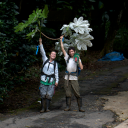How should a tree invest its resources in branches and leaves? These are expensive tissues to construct, and must return their carbon investment through photosynthetic returns. Some species have leaves spread throughout the canopy to capitalize on sunflecks (short bursts of sunlight from the high canopy) or shady conditions. Others have leaves only at the top of the canopy, to maximize their interception of sunlight, and shade out other species. Competition between plants for light can be cruel. Cecropia is one of the species that heads for the top, dropping lower branches as it continues to climb. The end result is a 30-100 foot high tree, with limbs and leaves only at the very highest points. This makes for very difficult pruning pole work – but we were successfully able to cut leaves off two trees today!
Notice the large holes in these leaves – insects are especially fond of them. One of the tradeoffs that comes with rapid growth, large leaves, and height, is a reduced ability to defend against herbivores. Defense chemicals have a high carbon cost, and little is left over after so much is invested in growth. Below is a very small caterpillar eating its way through the underside of a Cecropia leaf.
Some herbivores are themselves defended against predation – this caterpillar is covered in a formidable array of spines. These spines inject a chemical into whatever is unlucky enough to brush against them, causing a painful reaction and discouraging further investigation. I found this out the hard way. It is a sharp but numbing pain, that persists for several minutes – impressive for a creature not more than five millimeters long…
But not all insects are covered in spines – here is a hoverfly (I think) that greeted us on return from the forest today!



